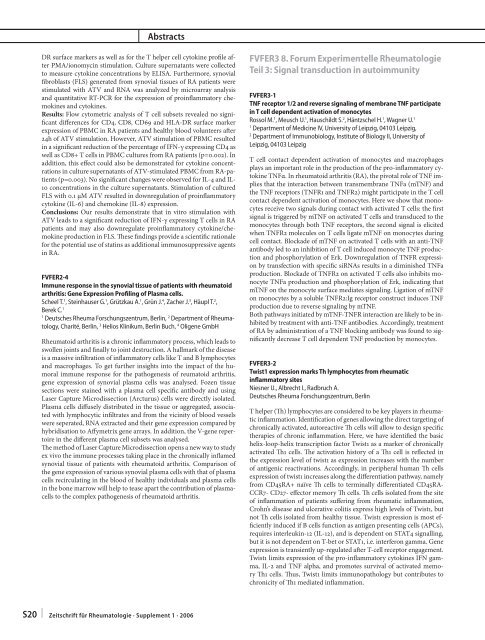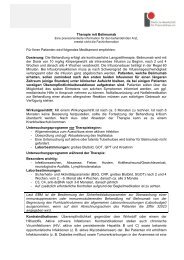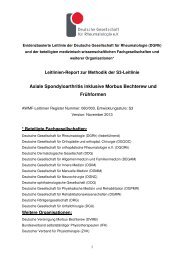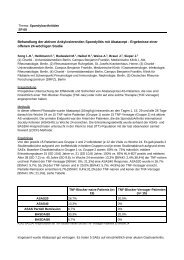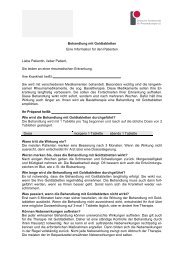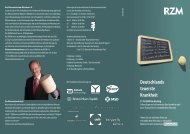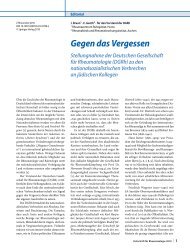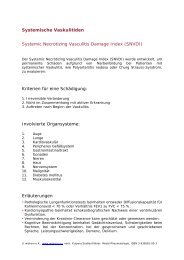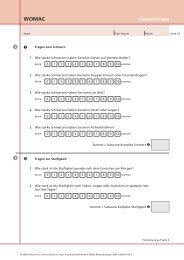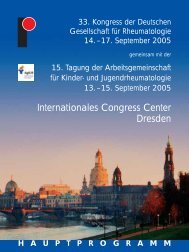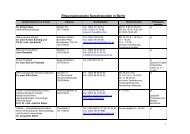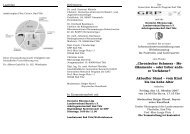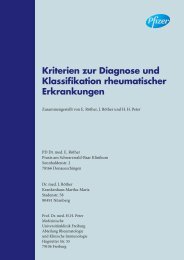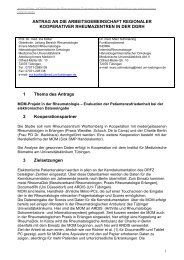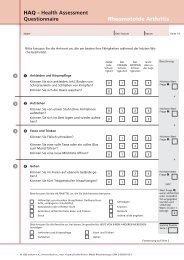Zeitschrift für Rheumatologie – Supplement 1 - Deutsche ...
Zeitschrift für Rheumatologie – Supplement 1 - Deutsche ...
Zeitschrift für Rheumatologie – Supplement 1 - Deutsche ...
Sie wollen auch ein ePaper? Erhöhen Sie die Reichweite Ihrer Titel.
YUMPU macht aus Druck-PDFs automatisch weboptimierte ePaper, die Google liebt.
S20<br />
Abstracts<br />
DR surface markers as well as for the T helper cell cytokine profi le after<br />
PMA/ionomycin stimulation. Culture supernatants were collected<br />
to measure cytokine concentrations by ELISA. Furthermore, synovial<br />
fi broblasts (FLS) generated from synovial tissues of RA patients were<br />
stimulated with ATV and RNA was analyzed by microarray analysis<br />
and quantitative RT-PCR for the expression of proinfl ammatory chemokines<br />
and cytokines.<br />
Results: Flow cytometric analysis of T cell subsets revealed no signifi<br />
cant diff erences for CD4, CD8, CD69 and HLA-DR surface marker<br />
expression of PBMC in RA patients and healthy blood volunteers aft er<br />
24h of ATV stimulation. However, ATV stimulation of PBMC resulted<br />
in a signifi cant reduction of the percentage of IFN-γ expressing CD4 as<br />
well as CD8+ T cells in PBMC cultures from RA patients (p=0.002). In<br />
addition, this eff ect could also be demonstrated for cytokine concentrations<br />
in culture supernatants of ATV-stimulated PBMC from RA-patients<br />
(p=0.003). No signifi cant changes were observed for IL-4 and IL-<br />
10 concentrations in the culture supernatants. Stimulation of cultured<br />
FLS with 0.1 μM ATV resulted in downregulation of proinfl ammatory<br />
cytokine (IL-6) and chemokine (IL-8) expression.<br />
Conclusions: Our results demonstrate that in vitro stimulation with<br />
ATV leads to a signifi cant reduction of IFN-γ expressing T cells in RA<br />
patients and may also downregulate proinfl ammatory cytokine/chemokine<br />
production in FLS. Th ese fi ndings provide a scientifi c rationale<br />
for the potential use of statins as additional immunosuppressive agents<br />
in RA.<br />
FVFER2-4<br />
Immune response in the synovial tissue of patients with rheumatoid<br />
arthritis: Gene Expression Profi ling of Plasma cells.<br />
Scheel T. 1 , Steinhauser G. 1 , Grützkau A. 1 , Grün J. 4 , Zacher J. 3 , Häupl T. 2 ,<br />
Berek C. 1<br />
1 <strong>Deutsche</strong>s Rheuma Forschungszentrum, Berlin, 2 Department of Rheumatology,<br />
Charité, Berlin, 3 Helios Klinikum, Berlin Buch, 4 Oligene GmbH<br />
Rheumatoid arthritis is a chronic infl ammatory process, which leads to<br />
swollen joints and fi nally to joint destruction. A hallmark of the disease<br />
is a massive infi ltration of infl ammatory cells like T and B lymphocytes<br />
and macrophages. To get further insights into the impact of the humoral<br />
immune response for the pathogenesis of reumatoid arthritis,<br />
gene expression of synovial plasma cells was analysed. Fozen tissue<br />
sections were stained with a plasma cell specifi c antibody and using<br />
Laser Capture Microdissection (Arcturus) cells were directly isolated.<br />
Plasma cells diff usely distributed in the tissue or aggregated, associated<br />
with lymphocytic infi ltrates and from the vicinity of blood vessels<br />
were seperated, RNA extracted and their gene expression compared by<br />
hybridisation to Aff ymetrix gene arrays. In addition, the V-gene repertoire<br />
in the diff erent plasma cell subsets was analysed.<br />
Th e method of Laser Capture Microdissection opens a new way to study<br />
ex vivo the immune processes taking place in the chronically infl amed<br />
synovial tissue of patients with rheumatoid arthritis. Comparison of<br />
the gene expression of various synovial plasma cells with that of plasma<br />
cells recirculating in the blood of healthy individuals and plasma cells<br />
in the bone marrow will help to tease apart the contribution of plasmacells<br />
to the complex pathogenesis of rheumatoid arthritis.<br />
| <strong>Zeitschrift</strong> <strong>für</strong> <strong>Rheumatologie</strong> · <strong>Supplement</strong> 1 · 2006<br />
FVFER3 8. Forum Experimentelle <strong>Rheumatologie</strong><br />
Teil 3: Signal transduction in autoimmunity<br />
FVFER3-1<br />
TNF receptor 1/2 and reverse signaling of membrane TNF participate<br />
in T cell dependent activation of monocytes<br />
Rossol M. 1 , Meusch U. 1 , Hauschildt S. 2 , Häntzschel H. 1 , Wagner U. 1<br />
1 Department of Medicine IV, University of Leipzig, 04103 Leipzig,<br />
2 Department of Immunobiology, Institute of Biology II, University of<br />
Leipzig, 04103 Leipzig<br />
T cell contact dependent activation of monocytes and macrophages<br />
plays an important role in the production of the pro-infl ammatory cytokine<br />
TNFα. In rheumatoid arthritis (RA), the pivotal role of TNF implies<br />
that the interaction between transmembrane TNFa (mTNF) and<br />
the TNF receptors (TNFR1 and TNFR2) might participate in the T cell<br />
contact dependent activation of monocytes. Here we show that monocytes<br />
receive two signals during contact with activated T cells: the fi rst<br />
signal is triggered by mTNF on activated T cells and transduced to the<br />
monocytes through both TNF receptors, the second signal is elicited<br />
when TNFR2 molecules on T cells ligate mTNF on monocytes during<br />
cell contact. Blockade of mTNF on activated T cells with an anti-TNF<br />
antibody led to an inhibition of T cell induced monocyte TNF production<br />
and phosphorylation of Erk. Downregulation of TNFR expression<br />
by transfection with specifi c siRNAs results in a diminished TNFa<br />
production. Blockade of TNFR2 on activated T cells also inhibits monocyte<br />
TNFa production and phosphorylation of Erk, indicating that<br />
mTNF on the monocyte surface mediates signaling. Ligation of mTNF<br />
on monocytes by a soluble TNFR2:Ig receptor construct induces TNF<br />
production due to reverse signaling by mTNF.<br />
Both pathways initiated by mTNF-TNFR interaction are likely to be inhibited<br />
by treatment with anti-TNF antibodies. Accordingly, treatment<br />
of RA by administration of a TNF blocking antibody was found to signifi<br />
cantly decrease T cell dependent TNF production by monocytes.<br />
FVFER3-2<br />
Twist1 expression marks Th lymphocytes from rheumatic<br />
infl ammatory sites<br />
Niesner U., Albrecht I., Radbruch A.<br />
<strong>Deutsche</strong>s Rheuma Forschungszentrum, Berlin<br />
T helper (Th ) lymphocytes are considered to be key players in rheumatic<br />
infl ammation. Identifi cation of genes allowing the direct targeting of<br />
chronically activated, autoreactive Th cells will allow to design specifi c<br />
therapies of chronic infl ammation. Here, we have identifi ed the basic<br />
helix-loop-helix transcription factor Twist1 as a marker of chronically<br />
activated Th 1 cells. Th e activation history of a Th 1 cell is refl ected in<br />
the expression level of twist1 as expression increases with the number<br />
of antigenic reactivations. Accordingly, in peripheral human Th cells<br />
expression of twist1 increases along the diff erentiation pathway, namely<br />
from CD45RA+ naïve Th cells to terminally diff erentiated CD45RA-<br />
CCR7- CD27- eff ector memory Th cells. Th cells isolated from the site<br />
of infl ammation of patients suff ering from rheumatic infl ammation,<br />
Crohn’s disease and ulcerative colitis express high levels of Twist1, but<br />
not Th cells isolated from healthy tissue. Twist1 expression is most effi<br />
ciently induced if B cells function as antigen presenting cells (APCs),<br />
requires interleukin-12 (IL-12), and is dependent on STAT4 signalling,<br />
but it is not dependent on T-bet or STAT1, i.e. interferon gamma. Gene<br />
expression is transiently up-regulated aft er T-cell receptor engagement.<br />
Twist1 limits expression of the pro-infl ammatory cytokines IFN gamma,<br />
IL-2 and TNF alpha, and promotes survival of activated memory<br />
Th 1 cells. Th us, Twist1 limits immunopathology but contributes to<br />
chronicity of Th 1 mediated infl ammation.


